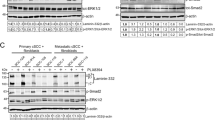Abstract
Squamous cell carcinoma (SCC) is one of the most common skin cancers. In the present study, we explored the effects of depletion of murine double minute gene 2 (MDM2) together with overexpression of N-myc downstream-regulated gene 2 (NDRG2) on cutaneous SCC. In order to achieve high efficiency of gene knockdown and overexpression in SCC-13 cells, recombinant adenovirus carrying siMDM2 and NDRG2 expression construct was produced. We found Ad-siMDM2, Ad-NDRG2, and Ad-siMDM2-NDRG2 infections inhibit the growth of SCC-13 cells in vitro, and Ad-siMDM2-NDRG2 infection has the highest inhibitory effect. Subcutaneous injections of Ad-siMDM2, Ad-NDRG2, and Ad-siMDM2-NDRG2 into SCC-13 xenograft nude mice resulted in the reduction of tumor volume. Moreover, we found that apoptosis protein caspase 3 was up-regulated in the Ad-siMDM2-, Ad-NDRG2-, and Ad-siMDM2-NDRG2-treated groups. Our data indicate that the adenovirus-mediated MDM2 silencing and NDRG2 overexpression can synergistically inhibit local cancer cell proliferation, induce apoptosis, and further prevent metastases of SCC. Our study provides a promising method that can be further developed as a new therapeutic approach against SCC.






Similar content being viewed by others
References
Chinembiri, T. N., et al. (2014). Review of natural compounds for potential skin cancer treatment. Molecules, 19(8), 11679–11721.
Masood, A., & Al-Jumaily, A. A. (2013). Computer aided diagnostic support system for skin cancer: A review of techniques and algorithms. International Journal of Biomedical Imaging. doi:10.1155/2013/323268.
Beddingfield, F. C. (2003). The melanoma epidemic: Res ipsa loquitur. Oncologist, 8(5), 459–465.
Vyas, R., et al. (2014). Squamous cell carcinoma of the scrotum: A look beyond the chimneystacks. World Journal of Clinical Cases, 2(11), 654–660.
Fernandez Garcia, M. S., & Teruya-Feldstein, J. (2014). The diagnosis and treatment of dyskeratosis congenita: A review. Journal of Blood Medicine, 5, 157–167.
Islamian, J. P., Mohammadi, M., & Baradaran, B. (2014). Inhibition of human esophageal squamous cell carcinomas by targeted silencing of tumor enhancer genes: An overview. Cancer Biology and Medicine, 11(2), 78–85.
Sakurai, F., & Mizuguchi, H. (2010). Development of recombinant adenovirus carrying microRNA-regulated gene expression system. Yakugaku Zasshi, 130(11), 1497–1504.
Ba, Y. H., & Li, H. P. (2006). Advances in study of murine double minute 2/p53 passway with breast cancer. Beijing da Xue Xue Bao, 38(5), 551–554.
Iwakuma, T., & Lozano, G. (2003). MDM2, an introduction. Molecular Cancer Research, 1(14), 993–1000.
Sun, Y. (2006). E3 ubiquitin ligases as cancer targets and biomarkers. Neoplasia, 8(8), 645–654.
Zhang, X., et al. (2014). Combined effects of genetic variants of the PTEN, AKT1, MDM2 and p53 genes on the risk of nasopharyngeal carcinoma. PLoS One, 9(3), e92135.
Melotte, V., et al. (2010). The N-myc downstream regulated gene (NDRG) family: Diverse functions, multiple applications. FASEB Journal, 24(11), 4153–4166.
Yao, L., Zhang, J., & Liu, X. (2008). NDRG2: a Myc-repressed gene involved in cancer and cell stress. Acta Biochimica et Biophysica Sinica (Shanghai), 40(7), 625–635.
Cao, W., et al. (2013). Low expression of N-myc downstream-regulated gene 2 in oesophageal squamous cell carcinoma correlates with a poor prognosis. BMC Cancer, 13, 305.
Wang, H., et al. (2012). Reduced N-Myc downstream-regulated gene 2 expression is associated with CD24 upregulation and poor prognosis in patients with lung adenocarcinoma. Medical Oncology, 29(5), 3162–3168.
Ma, J., et al. (2014). N-myc downstream-regulated gene 2 expression is associated with glucose transport and correlated with prognosis in breast carcinoma. Breast Cancer Research, 16(2), R27.
Lax, S. A., et al. (2001). Adenovirus-p53 gene therapy in human nasopharyngeal carcinoma xenografts. Radiotherapy and Oncology, 61(3), 309–312.
Seo, J. K., et al. (2014). A novel set of polyvalent primers that detect members of the genera Bromovirus and Cucumovirus. Journal of Virological Methods, 203, 112–115.
Sheng, W., et al. (2014). The relationship and clinicopathological significance of Numb, MDM2 and p53 expression in human pancreatic cancer. Zhonghua Wai Ke Za Zhi, 52(9), 675–681.
Donati, G., et al. (2013). 5S ribosomal RNA is an essential component of a nascent ribosomal precursor complex that regulates the Hdm2-p53 checkpoint. Cell Reports, 4(1), 87–98.
He, Y., et al. (2013). MDM2 inhibits axin-induced p53 activation independently of its e3 ligase activity. PLoS One, 8(6), e67529.
Momand, J., et al. (1992). The mdm-2 oncogene product forms a complex with the p53 protein and inhibits p53-mediated transactivation. Cell, 69(7), 1237–1245.
Chene, P. (2003). Inhibiting the p53-MDM2 interaction: An important target for cancer therapy. Nature Reviews Cancer, 3(2), 102–109.
Yu, Y., et al. (2006). Downregulation of MDM2 expression by RNAi inhibits LoVo human colorectal adenocarcinoma cells growth and the treatment of LoVo cells with mdm2siRNA3 enhances the sensitivity to cisplatin. Biochemical and Biophysical Research Communication, 339(1), 71–78.
Liao, H. (2014). N-Myc downstreamregulated gene 2 suppresses proliferation and induces oncosis of OSRC2 human renal cancer cells. Molecular Medicine Reports, 11, 1240–1245.
Liu, N., et al. (2007). Promoter methylation, mutation, and genomic deletion are involved in the decreased NDRG2 expression levels in several cancer cell lines. Biochemical and Biophysical Research Communications, 358(1), 164–169.
Ma, J., et al. (2012). Inhibition of endothelial cell proliferation and tumor angiogenesis by up-regulating NDRG2 expression in breast cancer cells. PLoS One, 7(2), e32368.
Yadav, R. K., et al. (2014). Endoplasmic reticulum stress and cancer. Journal of Cancer Prevention, 19(2), 75–88.
Gu, D. L., et al. (2013). Target genes discovery through copy number alteration analysis in human hepatocellular carcinoma. World Journal of Gastroenterology, 19(47), 8873–8879.
Trimarchi, M. P., Mouangsavanh, M., & Huang, T. H. (2011). Cancer epigenetics: A perspective on the role of DNA methylation in acquired endocrine resistance. Chinese Journal of Cancer, 30(11), 749–756.
Acknowledgement
This paper has been supported by the NSFC Grant No. 81171492.
Author information
Authors and Affiliations
Corresponding author
Rights and permissions
About this article
Cite this article
Wang, S., Chen, N., Dong, N. et al. Adenovirus siMDM2 and NDRG2 Gene Therapy Inhibits Cell Proliferation and Induces Apoptosis of Squamous Cell Carcinoma. Cell Biochem Biophys 73, 513–518 (2015). https://doi.org/10.1007/s12013-015-0691-8
Published:
Issue Date:
DOI: https://doi.org/10.1007/s12013-015-0691-8




